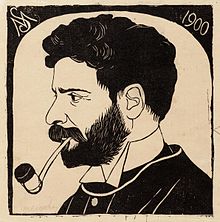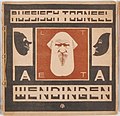Samuel Jessurun de Mesquita
Samuel Jessurun de Mesquita | |
|---|---|
 Self-portrait, 1900 | |
| Born | 6 June 1868 |
| Died | c. 11 February 1944 (aged 75) |
Samuel Jessurun de Mesquita (6 June 1868 – c. 11 February 1944) was a Dutch graphic artist active in the years before the Second World War. His pupils included graphic artist M. C. Escher (1898–1972).[1] A Sephardic Jew, in his old age he was sent to Auschwitz by the Nazis, where he was gassed along with his wife.
Early life and education[edit]
Samuel Jessurun de Mesquita was born on 6 June 1868 into a Jewish family living in Amsterdam. Though a member of a tightly knit Sephardic community, a minority among Dutch Jews, de Mesquita, like most of his contemporaries, was not religiously observant. His father, a secondary school teacher of Hebrew and German, died when Sam or Sampie, as he was called, was five.[2][3]
At the age of fourteen, the young de Mesquita applied to the Rijksakademie in pursuit of his artistic interests, only to be rejected. Deeply disappointed, he apprenticed himself to an acting city architect, for whom he worked for two years before entering a technical school with the intention of becoming an architect himself. He soon turned, however, to pedagogy and, in 1889, received a teacher's certificate, which would later enable him to support his family.[2][3]
Career[edit]

Over the next years, de Mesquita principally devoted himself to art, experimenting with various techniques and mediums. Though known primarily for his wood engravings, he also produced etchings, lithographs, watercolors and drawings; his applied art consisted mostly of material designs. There are birds, exotic animals, plants and flowers, and fantastical representations, both humorous and grim. Among de Mesquita's most beautiful works are his portraits, particularly his self-portraits.[2][3]
de Mesquita's work was included in the 1939 exhibition and sale Onze Kunst van Heden (Our Art of Today) at the Rijksmuseum in Amsterdam.[4]
With Nazi Germany's invasion of the Netherlands in May 1940, de Mesquita, already in poor health, was forced to lead a secluded life, limiting his work largely to sketches.[2][3]
Death[edit]
In the winter of 1944, on either 31 January or 1 February, the occupying German forces entered the home of the de Mesquita family in Watergraafsmeer, now part of Amsterdam, and apprehended him, his wife Elisabeth, and their only son Jaap. Transported to Auschwitz, Samuel Jessurun and Elisabeth were sent to the gas chambers within days of their arrival on 11 February; Jaap perished in the concentration camp at Theresienstadt on 20 March. Escher and some of Jaap's friends were successful in rescuing some of the works that had remained in the de Mesquita home.[2][3]
Covers for Wendingen[edit]
-
1925
-
1927
-
1929
-
1931
References[edit]
- ^ Locher, J. L. (1974). The World of M. C. Escher. Abrams. p. 5. ISBN 0-451-79961-5.
- ^ a b c d e Samuel Jessurun de Mesquita, Nederlands: Gemeentemuseum
- ^ a b c d e Es, Jonieke van (2005), Samuel Jessurun de Mesquita (1868–1944): Tekenaar, graficus, sierkunstenaar (in Dutch), Waanders Uitgevers, Zwolle
{{citation}}: CS1 maint: location missing publisher (link) - ^ "Onze kunst van heden, 1939 -". Beeldend BeNeLux Elektronisch (Lexicon). Retrieved 9 January 2021.
- Thomas Hengstenberg (Hrsg.): Samuel Jessurun de Mesquita: Von der Linie zur Fläche., Text dt. und engl., Bönen: Kettler, 2011. ISBN 978-3-86206-086-3.
External links[edit]
 Media related to Samuel Jessurun de Mesquita at Wikimedia Commons
Media related to Samuel Jessurun de Mesquita at Wikimedia Commons- Samuel Jessurun de Mesquita Collections on The Met
- 1868 births
- 1944 deaths
- Artists from Amsterdam
- Dutch graphic artists
- Dutch Sephardi Jews
- Jewish Dutch artists
- Jewish painters
- Dutch civilians killed in World War II
- Dutch Jews who died in the Holocaust
- Dutch people who died in Auschwitz concentration camp
- People killed by gas chamber by Nazi Germany
- Sephardi Jews who died in the Holocaust




